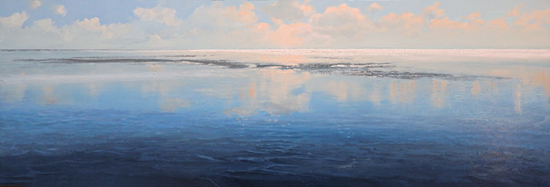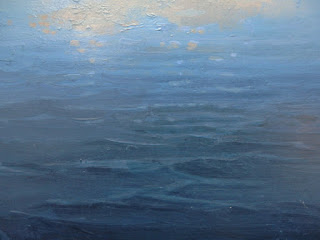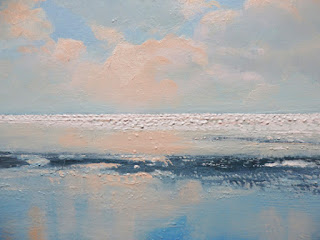Glazing is an age old technique, dating back to the 15th century. You apply thin, transparent layers on top of each other. Impasto is at the oppsosite side of the what-can-you-do-with-paint scale. You paint in thick, opaque layers that almost seem to come out of the canvas. Where as glazing tries to avoid texture, impasto is all about texture. In my painting 'Neap Tide' I used them both.
 |
| Neap Tide, oils on panel, 30 x 90 cm |
 In the lower part of the painting glazing was the dominant technique. On a dry bottom layer of dark blue I painted an even darker blue, a mix of indigo, Prussian blue and sepia. This mix was extremely thinned down with Liquin Light Gel, so the first layer was still shining through. With a cloth I then 'drew' the shapes of the small waves in the foreground by removing the dark glaze. By doing so the first blue layer became visible again.
In the lower part of the painting glazing was the dominant technique. On a dry bottom layer of dark blue I painted an even darker blue, a mix of indigo, Prussian blue and sepia. This mix was extremely thinned down with Liquin Light Gel, so the first layer was still shining through. With a cloth I then 'drew' the shapes of the small waves in the foreground by removing the dark glaze. By doing so the first blue layer became visible again.The next day I painted a mix of transparent white, ultramarine and sepia on top of the glaze, to soften the contrast between the bottom layer and
the glaze.
So, if you want to preserve your bottom layer but give it a different hue or partly place it in the shadow, glazing is a great option. You'll be surprised by the results.
 The sparkles at the horizon make up the lightest part of the painting. Here I used impasto. As you can see there's a fine texture formed by an awful lot of dots, each individual dot painted with a very fine brush. Here I used less Liquin to prevent the dots from flowing out into the background. Every dot has to stand out from the surface.That's important, because I want it to catch as much light as possible. The combination of the color (titanium white, vermillion red) and the 3D texture of the dots results in a surface that reflects a lot of light, which hopefully leads to the suggestion of sparkles on the water.
The sparkles at the horizon make up the lightest part of the painting. Here I used impasto. As you can see there's a fine texture formed by an awful lot of dots, each individual dot painted with a very fine brush. Here I used less Liquin to prevent the dots from flowing out into the background. Every dot has to stand out from the surface.That's important, because I want it to catch as much light as possible. The combination of the color (titanium white, vermillion red) and the 3D texture of the dots results in a surface that reflects a lot of light, which hopefully leads to the suggestion of sparkles on the water.If you want to find out more, please go to www.paintingskies.com/video. In the meantime, if you have questions I might be able to answer, please let me know!

Love this post,seems like what i am always want to do...Could be Liquin Original be used instead of 3d paste?TY and Happy New Year!ArthurZ
ReplyDeleteNo, liquin Original can not be used as 3d paste. For the impasto technique you need to add just a little medium (or no medium at all to your paint). I add just enough to make the dots I used in this painting.
DeleteGoede uitleg Jan Hendrik, bedankt
ReplyDeleteGraag gedaan, Paul!
Delete